1/350 USS Gambier Bay CVE-73

Reviewed by Sean Hert

AIRCRAFT |
|||||||
|
The kit includes 3 large aircraft sprues, all molded out of grey plastic. Each sprue has 3 aircraft sub-sprues of FM-2 Wildcats and TBF-1C Avengers, for a total of nine aircraft in this kit. (Casablanca class Escort Carriers typically carried a complement of approximately 30 aircraft when not ferrying) |
|||||||
| AQ- FM-2 WILDCAT | |||||||
|
There are 2 of these sub-sprues per larger aircraft sprue, giving you 6 total of these aircraft in this kit. The general shape of these planes is good, and Hasegawa has modeled the higher tail of the FM-2 Wildcat well. The panel line detail is nice and extensive, and the landing gear look good as well. The horizontal stabilizers are modeled separately from the fuselage, and do not appear to have any sort of positive-locator. Check your references to insure your tail surfaces have the correct angle, and are aligned properly. There are 2 variants of the lower fuselage/wing root areas; modeler's will have to decide before beginning construction if they wish to model each Wildcat with the wings folded or extended. |
|||||||
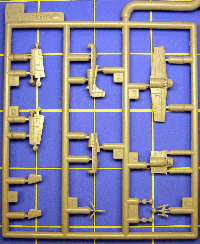 |
|||||||
|
|||||||
| AS- TBF-1C AVENGER | |||||||
|
Only one Avenger is included per, giving you only three TBF's in this kit. Like the FM-2, you have a folded wing option that requires the use of different lower fuselage. Interestingly, there is an internal hollow molded in the belly on both pieces; perhaps some intrepid modelers will build one with the doors open, and a tiny mk 13 torpedo being loaded! |
|||||||
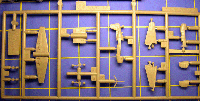 |
|||||||
|
|||||||
| CANOPIES | |||||||
|
Hasegawa has placed all the clear parts, in this case the canopies, all on one sprue. The TBF canopy includes the turret, and has some great detail present. The FM-2 canopies are pretty basic, as befitting the simple shape they had. Each canopy has a raised section for the sliding portion- a nice touch. This sprue also includes a canopy for the SBD- none of which are included in this kit, but they are available in the US Navy Carrier Based Aircraft Set. |
|||||||
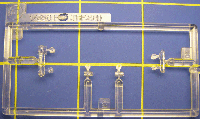 |
|||||||
|
|||||||
| AIRCRAFT DECALS | |||||||
|
As with the canopy sprue, the decals also include markings for SBD-5's. The set include the markings necessary for Composite Squadron VC-10 on board Gambier Bay during her short life in 1944, as well as a variety of markings with Stars and Bars from different era's during the war. |

|
||||||
|
|||||||
| DECAL | |
|
The decal sheet includes flight deck and flag decals, and load lines for the bow and rudder. Unfortunately, Hasegawa has included a 50-star US Flag; there were only 48 states at this time, so this is incorrect. |

|
| INSTRUCTIONS | ||||||||||||||||||||||
|
A 20 page instruction book is included, with an additional page/flyer correction for step 11. There is also a full 1/350 scale poster with a painting guide on one side, and a rigging guide on the reverse. Also included is a poster of Gambier Bay, and a guidebook with the particulars and story of USS Gambier Bay in both Japanese and English. Interstingly, the guidebook has a copyright of 2008. The instructions are pretty straighforward, and the kit seems uncomplicated in assembly. The instruction book's final page has a set of masks for painting the MS32/15a. These masks and the painting guide seem to vary slightly from photos of Gambier Bay, so as always, check your references. There is at least one minor error in the directions; on page 14, the funnels halves are mislabelled as "AP13" and "AP14"; these parts are on sprue E. |
||||||||||||||||||||||
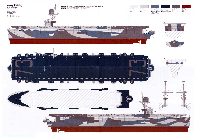 |
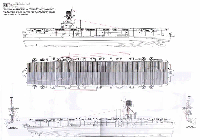 |
|||||||||||||||||||||
|
||||||||||||||||||||||
| CONCLUSIONS | ||||||||||||||||||||||

For many modelers, a Casablanca Class CVE, especially USS Gambier Bay CVE-73, as been a long suffering dream. Hasegawa has released a fine kit in this CVE, one which any modeler with some experience can build and enjoy. This kit should have included the 2 sky lookouts she had at the time of her sinking; the box art and included artwork certainly imply this kit was intended to represent her appearance in October of 1944. The apparent ease of the assembly and parts breakdown should not prove to be a challenge. As mentioned, to build a Gambier Bay at the time of her loss will require some modification. Nevertheless, this is a great looking model and should build up into a very nice CVE. Thanks to Great Planes Model Distributors for the review sample. It is listed as #40027 1/350 US Navy Escort Carrier USS Gambier Bay CVE-73 with a MSRP of $149.95 US. Great Planes is the exclusive US importer for Hasegawa. |
||||||||||||||||||||||
